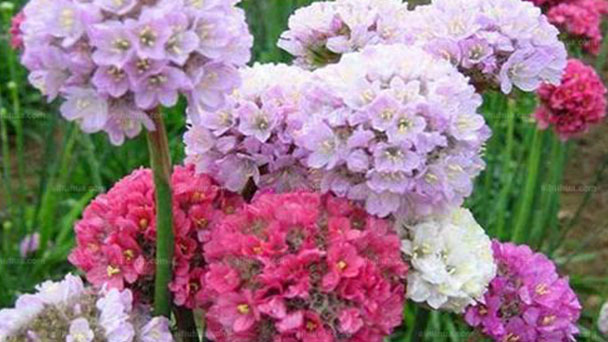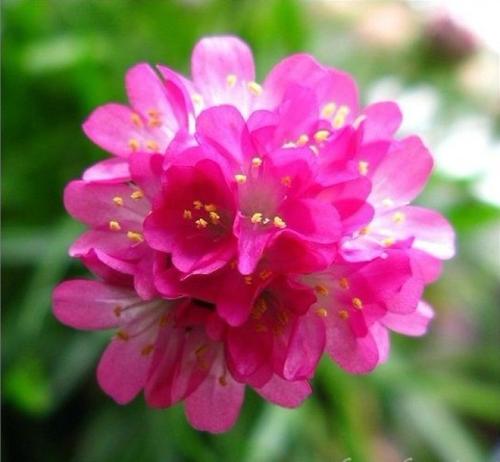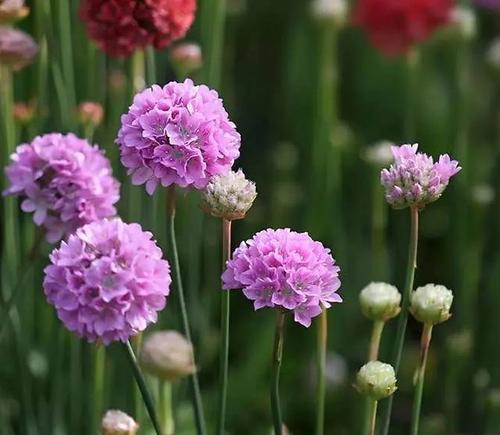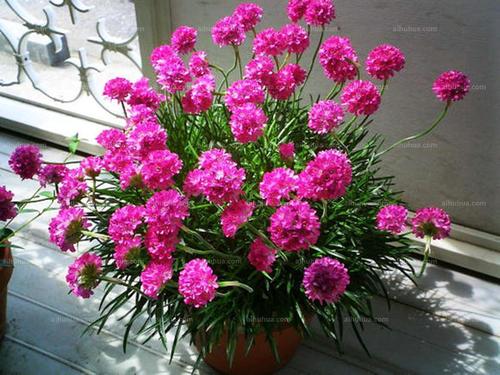Sea thrift (Armeria maritima) profile
Written by Maggie
Mar 11 2021

Sea Thrift (Armeria maritima), also called sea pink, is a perennial herbaceous plant of the family Paederaceae and Sea Thrift. It is native to Europe and America. Sea Thrift originally was a flower that grew on the coast with dry petals, and small flowers clustered together to form dense globes, which could form a very beautiful landscape.
The sea thrift colors are peach and white. Originated in southern Europe, it can be roughly divided into broad-leaved species and fine-leaved species. The most common potted plants are fine-leaved species. The broad-leaved flowers are larger and commonly used for cut flowers. The pedicels emerge from the leaves with small globular heads, like ancient hairpins, so they are called Sea hairpins. When the flowers of the fine leafed species have faded, the dark green needle-like leaves can also act as a lawn if one is planted.
Sea thrift picture

The morphological characteristics of sea thrift
Sea Thrift is a perennial rhizome flower of the genus Pinus in the family Cyanaceae. The plants are low, tufted and 20-30 cm high.Leaves basal, linear sword-shaped, pink to rose-red flowers, entire, dark green;
The Sea thrift stems are long and thin, with small flowers clustered at the top. It is semicircular, purplish red, and its flower stem is about 3 cm.
Sea thrift plants are low, caespitose and only 8 -- 12 cm tall. Leaves are linear, sword-shaped, entire, dark green; The flower stem is long and thin, and the florets are clustered at the top of the flower stem. It is semicircular and purplish red.
The ecological habits of sea thrift
Sea Thrift tends to prefer sunny, well-drained sandy soils. Organic matter rich leaf rot is preferred for cultivation.
Sea Thrift needs to be well drained and well lit. Sea Thrift likes warm, avoids high temperature and high humidity, the suitable temperature for growth is 15~25℃.
How to grow and care for sea thrift
Substrate
Sea Thrift is best found in leaf-rich soil that is rich in organic matter.
Temperature and light
The optimum temperature of Sea Thrift growth was 15~25℃, and it required sufficient sunlight during the growth period, and it was placed in a place with sufficient sunlight. In summer, scattering light was appropriate to avoid the hot sun exposure. When the temperature is high, shade and cool down.
Water care
Sea Thrift does not require much fertilizer, so Huabao No. 2 should be applied with 1000 times dilution every two or three weeks for cultivation. You've got to water it in moderation, and you've got to water it a lot when the temperature is high or the water is cold or after a long drought, you're going to do damage to the roots of the Sea Thrift system.
The way sea Thrift propagates
Sea Thrift is usually propagated by division, and the best time for Sea rift is from autumn to winter. Leaf-rot soil rich in organic matter is the best cultivation soil. Drainage and lighting should be good. Sea Thrift is fond of warmth and avoids high temperature and humidity. The suitable temperature for growth is L 5 ~ 25℃.
Seed propagation
Spring flowering after overwintering is sown in summer (in open air) or autumn (in glass or thin-film greenhouses). The flower seeds were lightly covered with vermiculite and kept at a balanced humidity. It took 7-10 days to sprout at 20℃ to 21℃.
Cotyledons fully expanded (growth period Ⅱ) after the temperature dropped to 17 ℃ ~ 20 ℃, and reduce soil moisture. 6 to 8 weeks after sowing, place one seedling in an 8 to 15 cm pot, or two to three seedlings together in a 10 to 12 cm pot.
The upper basin substrate is a loose and coarse grass native, and the pH value is maintained at 5.8~7.0. The temperature is 13℃~17℃, 3℃~5℃ overwintering without frost, or the application of fabric covering in the open air can also be overwintering. It takes 10 to 11 weeks for spring flowering when the temperature is 15℃ to 18℃, and the low temperature of 7℃ to 12℃ will slow down the growth and lead to prolonged growth cycle. Growth will stop when the temperature is below 7℃.
Division propagation
Autumn to winter is the suitable period. When dividing the Sea Thrift, dig out the cluster seedlings, separate each plant by 1~2 buds with a sharp knife, plant them in the pot, strengthen conservation, and pay attention to heat preservation in winter.

Disease control of sea thrift
Rust
It harms leaves and flower stems of Sea Thrift, and produces blister spots on leaves and stems at the beginning of the disease, which is the spore heap of germs.In the middle stage of the disease, the epidermis ruptured and the yellow-brown powder, the summer spores of the pathogen, appeared. Sometimes the whole leaf turns yellow. At the late growth stage of the host, there are black long elliptic or short linear piles of winter spores. Aspartame Spores are piled under the epidermis and do not break through the epidermis. Summerspore heap and winter spore heap are mostly on the dorsum of leaves.
Method of prevention and cure
Strengthen cultivation management: potted plants should choose loose, good drainage culture soil, large area planting, to choose high terrain, drainage unblocked place. Pay attention to ventilation and light, frequently remove weeds, reasonable application of nitrogen, phosphorus and potassium fertilizer, avoid excessive nitrogen fertilizer, etc.
The removal of pathogens: in late autumn or early spring, thoroughly clear and burn the diseased plant residues.
Chemotherapy: during the growth period, spray 63% DeSen Zinc 600 times liquid prevention and treatment. After the onset of the disease, spray with internal absorption bactericidal effect of 23% powder rust ning 1500~2500 times the liquid or 96% enemy embroidery sodium 250 times the liquid or 50% wilting rust Ling wet powder 1500 times the liquid.
Starscream
Red spider overwintering with eggs, overwintering eggs generally begin to hatch in early spring.
Control methods: When the pest is serious, use 1.8% abamectin emulsion 7000~9000 times liquid uniform spray control; Or the use of 15% pyridin emulsion solution of 2500~3000 times have better control effect. The control can also be carried out with 40% dichromatol emulsion of 1000~1500 times, 20% net wet powder of mite death of 2000 times and 1.8% acaricin emulsion of 6000~8000 times. If the new high lipid membrane synergism is added to the pesticide, the very ideal results will be obtained.
Variety classification of sea thrift
Sea Thrift "Ornament" (Armeria hybrida "Ornament") is 30 cm tall, with a variety of bright colors, and evergreen leaves.
The Sea Thrift "Loo" (Armeria Maritime "Laucheana") is 20 cm tall with bright pink flowers in clusters that last a long time.
The Sea Thrift "Morning Star" (Armeria Maritime "Morning Star") was about 15 cm tall, compact, with dark green leaves, showy, deep rose red flowers, many flowers, long flowering, no vernalization needed, and the first year of flowering. Can be planted in the rock courtyard, container cultivation, also can be used as a flower.
The distribution of sea thrift
Sea Thrift was originally developed in Europe and America, but is now cultivated in many parts of the world.
Sea Thrift was originally a flower that grew by the Sea. The petals are dry and the florets cluster together to form dense globes. Groups can form a very beautiful landscape. Small and lovely flowers, bright colors, suitable for flower bed beautification, small pot or ground.
Uses of sea thrift
Ornamental value
The sea thrift plants are grown at a low height and have a wide range of uses in horticulture, from pot plants to flower beds, landscaping and rock yards. It is a spring flowering plant, a small plant form is deeply loved by people. During the flowering period, the compact plant produces a large number of rose pink flowers. The bright color, long flowering and dark green grassy leaves are very popular.
The garden use of sea thrift
Sea Thrift thrives on sunny, well-drained sandy soils and can be used for flower beds, flower borders, rock gardens, cut and potted flowers.
Sea Thrift is cute and small, and the flowers are bright and good for flower beds or small potted plants or ground covers.

Latest Updated
- Benefits of Bugleweed - 7 Science-backed Health Benefits
- Bugleweed Dangers & Side Effects - Is It Poisonous?
- How to Plant Evergreen Trees - What You Should Know
- When to Plant Evergreens - Grow Guide for Evergreen Trees
- 12 Wonderful Evergreen Shrubs for Your Garden
- 12 Popular Evergreen Plants with Pictures for Beginners
- When And How To Prune A Lilac Bush Like a Pro
- How to Grow & Care for Lilac Vine (Hardenbergia Violacea)
- Japanese Lilac Tree (Syringa Reticulata) Care & Propagation Guide
- Shumard Oak Pros and Cons - What to Know
Popular Articles
- Winter maintenance of Antirrhinum Majus
- How to Grow Terminalia Mantaly Tree
- How to Grow and Care for Crossostephium Chinense
- How to grow Antirrhinum Majus in spring
- Peristeria Elata (Dove Orchid) Profile: Info & Care Guide
- Underwatered Snake Plant (Sansevieria Trifasciata) - Signs And How To Fix
- How to Care for Brazilian Jasmine Plant (Mandevilla Sanderi)
- How to Grow & Care for Graptopetalum Purple Delight in Summer
- Rosa Chinensis (China Rose): Plant Growing & Care Tips
- How to Care for Baby Sun Rose (Aptenia Cordifolia)